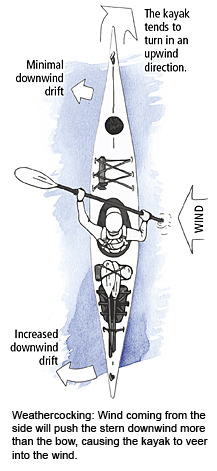In calm conditions, a sweep stroke is usually sufficient to turn a kayak, but when the wind blows, turning a kayak may require something more. Depending on the relative direction of the wind and the direction you want to turn, some strokes will work more effectively than others. In choosing which strokes to use, it’s helpful to understand how the forces imparted by the wind and the water affect the directional control of a kayak. You don’t have to struggle in the wind if you use strokes that let the wind do some of the work for you.

Weathercocking
As the kayak moves forward through the water, the bow and stern encounter different forces. The bow moves forward into undisturbed water and pushes it aside. At the stern, the water moves back in to fill the void created by the passage of the middle of the kayak, leaving turbulent water in the kayak’s path. In calm air, these forces are balanced on both sides of the kayak. But if the wind is blowing against the side of the kayak and pushing it sideways (and here we’ll be considering the behavior of kayaks without rudders or skegs or with those devices retracted), the bow meets more resistance in the undisturbed water than the stern meets in the turbulent water.
Because the stern of a forward-moving kayak has lower lateral resistance than the bow, it is more readily pushed downwind. The net result is that the kayak changes its heading, a phenomenon referred to as weathercocking. From the paddler’s perspective, the bow seems to be pulled up into the wind. As the paddling speed increases, difference in lateral resistance between bow and stern grows and the kayak veers more forcefully upwind.
Choosing your strokes to work in concert with the forces imparted by the wind on the kayak will improve your performance and reduce the effort required to manage your kayak. Turning the kayak in the wind begins with good forward speed and by using the paddle effectively on both sides of the boat. For turning in wind, you’ll need good basic skills with the sweep stroke and bow and stern rudders.
The Forward Sweep Stroke
The forward sweep stroke is the fundamental stroke for turning a sea kayak. The sweep is a modified forward stroke that adds to forward momentum and causes the kayak to turn. Consider a turn to the right—the stroke is preceded by an initial upper torso twist clockwise and then the left paddle blade is planted well forward on the left side of the kayak. During the stroke, you unwind the lower torso to turn the kayak against the resistance of the paddle. At the end of the sweep, you’ll have to withdraw the paddle blade from the water quickly or it will reduce the momentum of your turn.
The sweep stroke uses only one paddle blade, but you can use both blades to turn. For more turning power, combine two strokes into a smooth sequence, and follow the sweep stroke on one side with a bow rudder or a stern rudder on the opposite side.
The Bow and Stern Rudders
Rudder strokes are performed by placing the blade either forward or aft of your hips and holding it in a static position. The power face of the paddle is the side normally facing you (usually the concave face bearing the manufacturer’s label) and the back face is the side normally facing away from you. For a bow rudder in the wind, the paddle shaft is held in a nearly vertical orientation, and the blade is placed in the water at a forward position near or beyond your knees. The power face of the blade is toward the kayak, with the leading edge of the blade rotated slightly outward, creating an angle of attack that pulls the bow into the turn.
A stern rudder works in a very similar way but has the paddle shaft in a more horizontal orientation, with the blade placed well aft of your hip. The blade is in a nearly vertical plane and the power face is toward the kayak. The paddle shaft is positioned to create an angle of attack so that the water pushes against the back side of the blade, which then pushes the stern to the outside of the turn. Effective bow and stern rudder strokes require subtle adjustments of blade position and angle of attack.

